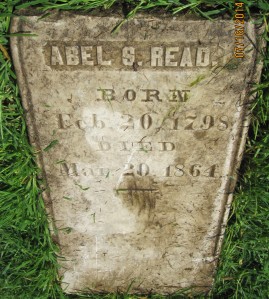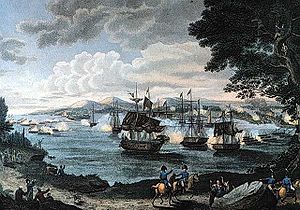I guess I should say rather, the mystery of his tombstone. When excavations were done earlier in the summer for the water line construction south of the new Route 40 bridge over the Hoosic River, the front sidewalk of the DiFranzo’s, the old Rectory, was disturbed, and lo and behold, one of the big sections was a tombstone. (Abel S. Read, 1798-1864) Fortunately one of the discoverers was Frank Crandall, an aware local resident, who made sure the stone was saved, only slightly damaged. Village Historian Dick Lohnes was called in and he called me.

tombstone of Abel Read, part of DiFranzo’s front walk
After some research, I have discovered that Abel Spalding Reed was born on February 20, 1798 in Brooklyn, Connecticut, the son of the amazingly named Barzillai and Elizabeth Read. They were married April 7, 1797 and had two more children before Elizabeth died in 1802, aged 29. Abel’s first appearance in Schaghticoke records is in May 1830, when he married Catherine (Cathaline, Caroline) Waldron in the Dutch Reformed Church. He was 32 years old, listed as a teacher. She was 26, the daughter of farmer Peter C. Waldron. Peter Waldron and his wife Cate or Catherine had several children baptized in the early 1800’s in the church, but Catherine’s baptism is not listed. Waldron was an old family in town. It’s hard to tell when Abel arrived in Schaghticoke. The 1855 census stated he had been in town for forty years, which would put his arrival in 1815, as a 17-year-old. That seems a bit early to have enough education to be a teacher, but is possible. He is in neither the 1820 or 1830 census, but if he roomed with a family, as was often the case with a school teacher, he would not have been listed by name, just as a resident in a family. In the 1830 census, Peter C. Waldron does have one female aged 20-30 in his family, who could be Catherine.
Sylvester’s History of Rensselaer County records that Abel was a school inspector sometime in the period from 1813-1844. I am sure he stayed in town, but the next recorded mention of Abel is in the 1850 census, when he was still listed as a school teacher, aged 50. I have not seen this before- most male teachers worked for just a couple of years as young men, then went on to their “real” careers, but this would mean he had been a teacher for at least twenty years. He and Catherine, 45, plus their children William, 14, and Mahilla (Mehitabel), 6, lived with her father, Peter C. Waldron, aged 73.
By the 1855 census, they were living on their own and Abel’s occupation was farmer. (Peter, born in 1777, lived until 1866, and is buried in Elmwood Cemetery.) Abel, with an estate of $500, was aged 57. Now son Peter, aged 22, was living with the family, along with William, 20, and Mehitabel, 11. On the 1856 map of town, their farm was on the south side of Pinewoods Road, just west of where Sliter Road joins it. By 1860, Abel had real estate worth $3400 and a personal estate of $800. The three children still lived with their parents, with Peter and William both listed as farmers. Next door on the census was the family of a Zachariah Read, age 24, married to Ann, with a son Charles, age 11/12. Could this be another son of Abel and his wife? It’s certainly possible. In the 19th century, men aspired to be farmers, so this could represent teacher Abel finally reaching his goal.
Abel died on March 20, 1864. We don’t know where he was buried. The site where his stone was found would certainly point to interment in the Catholic Cemetery, which in 1864 was next to the church, and later moved to the current location. This seems unlikely as he was married in the Dutch Reformed Church, therefore probably not a Catholic, and the stone was trimmed at the top edge for use as a paving stone in the walk.
The 1865 census continued to list Catherine, his widow, now aged 61, with an estate of $900. She had had five children. Peter, William, and Mehitable still lived with her. By the 1870 census, Peter, now 38, was listed as the head of family, with an estate of $4115. Brother William lived with him, along with their mother, now 64, listed as “keeping house.” She had an estate of $400. Mehitabel married a Hasbrouck. Catherine died in 1877.
By the 1880 census, Mehitable was back home with her brothers, along with a daughter, Emma, aged 10. The three siblings were still living together as of the 1905 census, still on the farm on Pinewoods Road, which I know as the former farm of Mike Bunk. William died in 1911. Peter and Mehitable moved in with her daughter, Emma or Emily, and her husband Luther Moon, who lived in the same part of town. They were still there in the 1925 census, Peter aged 92 and Mehitable 81. Peter died in 1926 and Mehitable in 1928.


stone of Abel and wife at Hudsonview
So the reason for the location of Abel’s tombstone will have to remain a mystery. It seems likely that it just became redundant, as the whole family has a plot in Mechanicville’s Hudsonview Cemetery. Somehow the slab became available for reuse after the new stone was erected. But it was important for me as it allowed me to find out about the earliest career teacher in town I have ever found. I still don’t know where Abel was educated, and why he ended up here- though many people from Connecticut moved to the booming industrial village of Schaghticoke in the early 19th century. Where did he teach? As far as I know there were just one-room elementary schools in town before the Civil War. Was there something more? Was Abel renowned as a prominent local teacher? Or not? Did any of Abel’s children follow in his footsteps? We know only that two sons became farmers, one daughter a farm wife. It’s fun to speculate.



